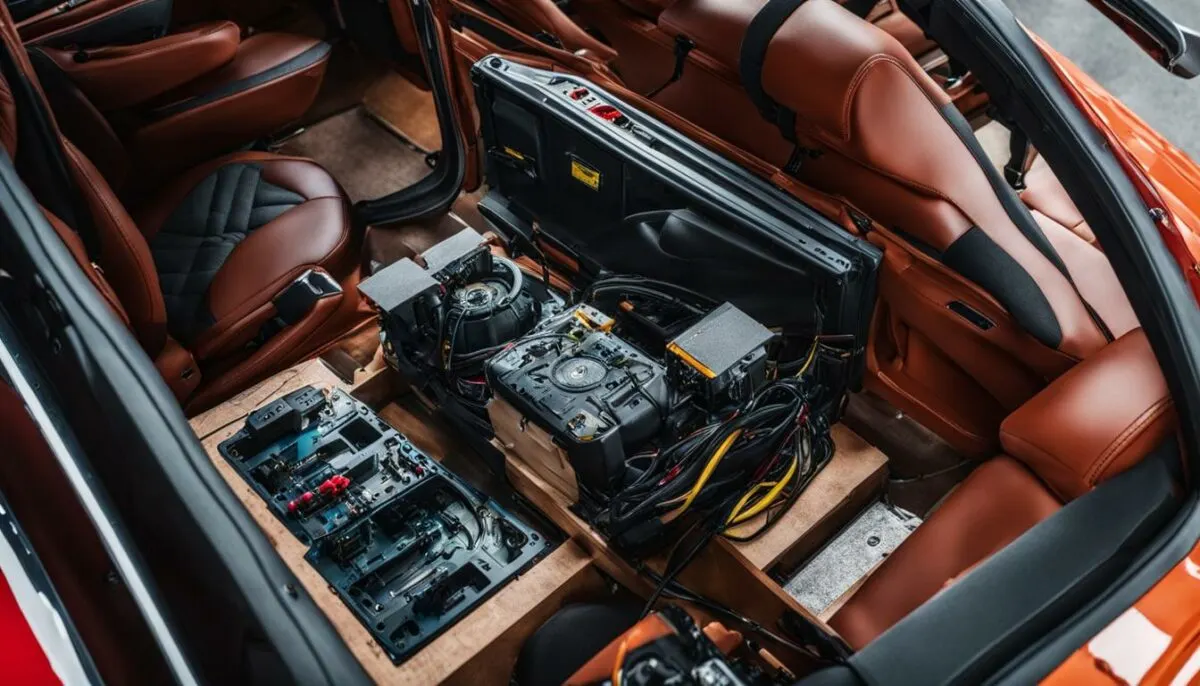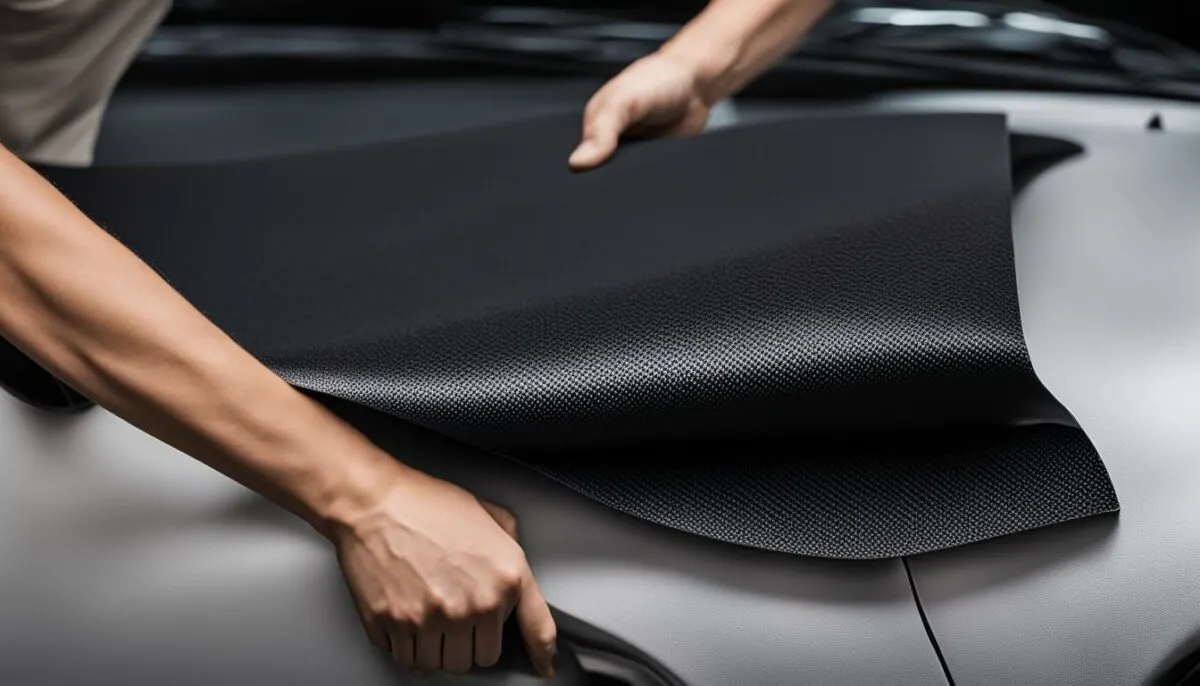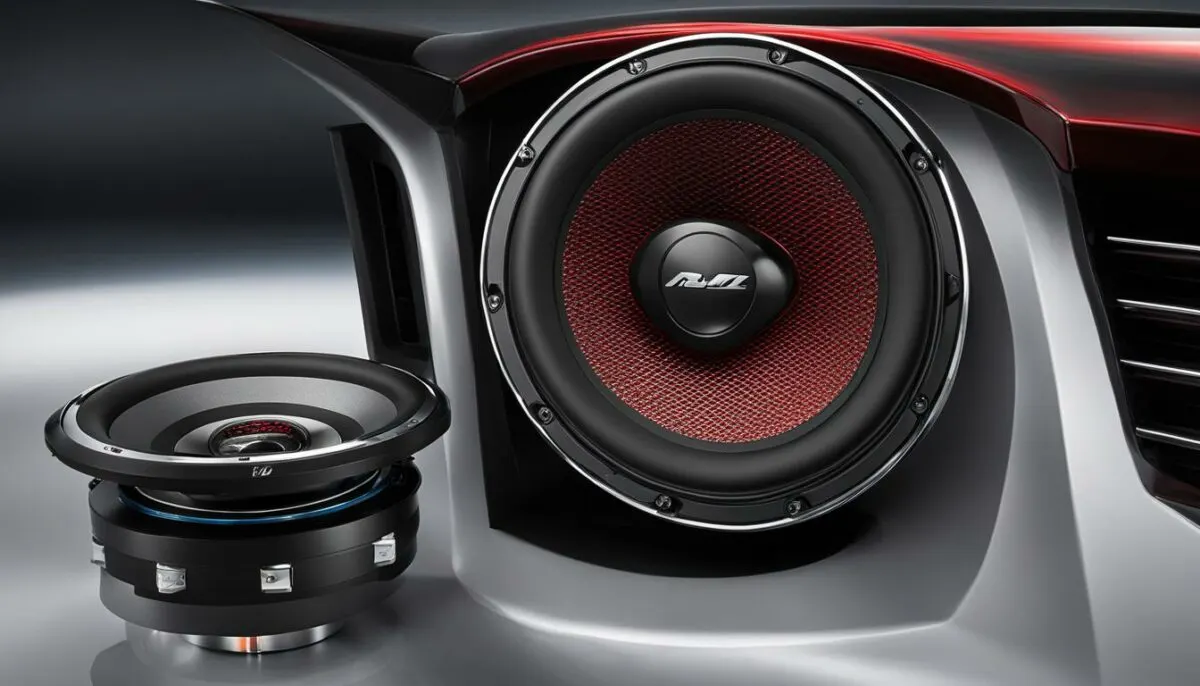If you’re a car enthusiast or simply looking to improve your audio experience while on the road, understanding midrange in car audio is crucial. Midrange speakers and frequencies play a vital role in reproducing the middle range of frequencies, responsible for vocal clarity, instrument details, and mid-level tones in music. In this comprehensive guide, we’ll explore the concept of midrange in car audio and its significance in enhancing your vehicle’s sound system.
Key Takeaways:
- Midrange speakers handle frequencies within a specific range, typically between 250 Hz and 2,000 Hz.
- Midrange frequencies in car audio are crucial for achieving a balanced and immersive listening experience.
- Choosing the right midrange speakers for your car audio system can greatly impact the overall sound quality.
- Proper installation, optimization, and soundproofing of midrange speakers can enhance their performance and your overall audio experience.
- Deepening your understanding of car audio systems and their components is key to improving and refining your car audio setup.
Defining Midrange Speakers
Midrange speakers are an integral component of your car’s audio system that reproduces a range of sounds between 250 Hz and 2,000 Hz. They work alongside other speakers to deliver a balanced and well-defined sound experience.
The human ear is most sensitive to sounds in this midrange frequency, making it essential for delivering clear and accurate instrumentals and vocals. When your car audio system includes midrange speakers, it ensures a balanced sound that enhances the overall music experience.
The size and type of material used in the construction of midrange speakers can impact their performance. For example, larger speakers generally produce better low and midrange sounds, while smaller ones are more suitable for high frequencies. The materials used in the construction can also significantly affect the sound quality. For example, metal-cone midrange speakers generally offer a more precise and controlled sound than paper-cone ones.
Understanding the specifics of midrange speakers is essential when designing or upgrading your car’s audio system. In the next section, we will explore the significance of midrange in car audio and how midrange frequencies can enhance your driving soundtrack.
The Importance of Midrange in Car Audio

The benefits of midrange speakers and frequencies in car audio cannot be overstated. Midrange frequencies fall within the range of 250 Hz to 2,000 Hz and are responsible for reproducing vocals, instruments, and mid-level tones. By accurately reproducing these frequencies, midrange speakers are essential in achieving balanced and immersive listening experiences.
One key advantage of midrange speakers is their ability to provide greater clarity and detail in music. Without properly functioning midrange speakers, vocals and instruments can sound muddled, flat, or indistinct, leading to an unsatisfactory listening experience.
Another benefit is that midrange speakers can help to fill in the sound spectrum in your car audio system. By accurately reproducing midrange frequencies, they work alongside other speakers, such as subwoofers and tweeters, to create a seamless and full-bodied listening experience that enhances the overall quality of sound in your car.
Midrange speakers can also help to reduce listener fatigue. Unlike low or high frequencies, midrange frequencies are less likely to cause listening fatigue, making them an excellent choice for extended listening sessions. This can be especially important on long road trips or commutes where you may be listening to music for extended periods.
Overall, incorporating midrange speakers into your car audio system can provide significant improvements in sound quality, clarity, and detail. They work in conjunction with other speakers to create a complete and enjoyable listening experience. Whether you are a music lover or a car enthusiast, investing in midrange speakers can take your car audio system to the next level.
Choosing the Right Midrange Speakers

If you’re looking to take your car audio experience to the next level, selecting the right midrange speakers is crucial. With so many options available, it can be overwhelming to determine which ones best fit your needs. Here are some factors to consider when choosing the best midrange speakers for your car audio system:
- Power handling: Make sure the power handling capacity of the speakers matches the output of your car’s amplifier to avoid distortion or damage.
- Sensitivity: Look for high sensitivity ratings to maximize the speakers’ performance with the available power.
- Impedance: Ensure the speakers’ impedance is compatible with your car’s audio system to prevent impedance mismatches that can degrade sound quality.
- Frequency response: Select speakers with a frequency response that complements your music preferences, typically between 80 Hz to 5 kHz for midrange speakers.
- Speaker size: Choose speakers that fit into the available space in your car without compromising sound quality.
One of the most important things to keep in mind when selecting midrange speakers is that they should blend well with your car’s existing audio setup. The best way to ensure this is to listen to different speakers and compare their sound quality in person. Some of the best midrange speakers for car audio include:
| Speaker Name | Power Handling | Sensitivity | Impedance | Frequency Response |
|---|---|---|---|---|
| Alpine SPR-60C | 330W | 88 dB | 4 ohms | 65 Hz – 29 kHz |
| JL Audio C5-525 | 225W | 89 dB | 4 ohms | 53 Hz – 25 kHz |
| Focal 165AS | 120W | 91 dB | 4 ohms | 60 Hz – 20 kHz |
Remember to take your time and choose midrange speakers that fit your budget and sound preferences. The right speakers can make a significant difference in your car audio system’s overall performance.
Midrange Speakers vs. Tweeters
When it comes to car audio systems, understanding the difference between midrange speakers and tweeters is crucial. While midrange speakers handle the middle range of frequencies, tweeters focus on reproducing high-frequency sounds. Let’s take a closer look at the distinctions between these two types of speakers.
Differences in Frequency Range
Midrange speakers are designed to reproduce sounds within a specific frequency range, typically between 250 Hz and 2,000 Hz. This makes them ideal for reproducing the middle range of frequencies, responsible for vocal clarity, instrument details, and mid-level tones in music.
Tweeters, on the other hand, are designed to handle high-frequency sounds, typically above 2,000 Hz. These include cymbals, high-pitched vocals, and other similar sounds.
Working Together for Balanced Sound
While midrange speakers and tweeters have different frequency ranges, they are equally important in achieving a well-balanced and immersive sound system in your car. By working together, they can create a full spectrum of sound, from the low bass tones to the high-pitched treble sounds.
In some car audio systems, midrange and tweeter speakers are combined into a single component known as a coaxial speaker. This can simplify installation and provide a more compact and integrated design.
Choosing the Right Combination
Choosing the right combination of midrange speakers and tweeters is essential for achieving optimal sound quality in your car. Some car audio enthusiasts may prefer a setup with more midrange emphasis, while others may prioritize high-frequency sound reproduction. The choice ultimately depends on personal preference and listening habits.
When selecting midrange speakers and tweeters, it’s important to consider factors such as power handling, sensitivity, impedance, and frequency response. Working with a professional car audio installer can ensure that you choose the best speakers for your needs and preferences.
Now that we’ve explored the differences between midrange speakers and tweeters, let’s move on to selecting the right midrange speakers for your car audio system in the next section.
Installing Midrange Speakers

Proper installation of midrange speakers is crucial to optimize their performance and ensure they blend seamlessly with your car’s audio system. Here’s a step-by-step guide to installing midrange speakers:
- Choose a location: Identify a suitable location for your midrange speakers, such as a door panel or dashboard. Ensure they are not obstructed and can project sound waves effectively.
- Measure: Take accurate measurements of the speaker’s dimensions and the installation area’s size to avoid any surprises later on.
- Prepare the wiring: Before you install the speakers, make sure the wiring is in good condition. Replace any frayed or damaged wires and secure them with wire ties.
- Remove old speakers: If your car has factory-installed speakers, remove them carefully. Unscrew the fasteners and detach the wiring connectors.
- Mount the speakers: Using specialized adapters or brackets, mount the midrange speakers onto the installation area. Ensure they fit securely and do not rattle or vibrate.
- Connect the wiring: Connect the wiring from the speakers to your audio system. Use the wiring diagram provided by the manufacturer to ensure the correct polarity and avoid damaging the speakers.
- Test the sound: Before putting everything back together, test the sound quality of your new midrange speakers. Adjust the equalizer and sound settings, if necessary, to achieve the desired sound.
- Secure the speakers: Once you’re satisfied with the sound quality, secure the speakers and fasten any loose wires or connectors.
- Add soundproofing: To enhance midrange performance and minimize external noise interference, add soundproofing materials to the installation area.
Expert Tip:
For optimal midrange performance, aim the speakers towards the center of the car, closer to ear level. This helps to direct sound waves towards the listener and improve overall sound quality.
“Proper installation of midrange speakers is vital to optimize their performance and ensure they seamlessly integrate into your car’s audio system.”
Optimizing Midrange Performance

Optimizing car audio midrange performance requires attention to detail and some technical knowledge. Here are some tips and techniques to help you get the best sound quality from your midrange speakers:
- Equalization: Adjusting your car’s equalizer settings can help fine-tune the midrange frequencies. Boosting or cutting the midrange frequency band can enhance or reduce specific elements of the sound, such as vocals or instruments. Experiment with different settings and listen carefully to find the sweet spot.
- Sound staging: Proper sound staging can enhance midrange performance by creating a more natural and immersive listening experience. Installing midrange speakers in the right locations (e.g., dashboard, door panels) and using sound imaging techniques can help create a realistic soundstage.
- Crossover settings: The crossover is responsible for dividing the audio signal into different frequency ranges and sending them to the appropriate speakers. Tweaking the crossover settings can help optimize midrange performance by ensuring the midrange speakers receive the correct frequencies within their optimal range.
By applying these tips, you can fine-tune your car audio system for exceptional midrange sound reproduction. But how do you know if you’ve achieved the best possible sound quality? Let’s explore some objective measures of midrange performance.
Measuring Midrange Performance
There are various ways to measure midrange performance, including:
| Measure | Description |
|---|---|
| Frequency response | Measures the range of frequencies a speaker can reproduce and how accurately they are reproduced. Midrange speakers should have a flat frequency response within their range (e.g., 250 Hz – 2,000 Hz). |
| Harmonic distortion | Measures the amount of distortion introduced to the midrange sound. The lower the percentage of harmonic distortion, the better the sound quality. |
| Sensitivity | Measures how efficiently a speaker converts power into sound. Higher sensitivity means more sound output per watt of power. |
By paying attention to these measures and taking steps to optimize midrange performance, you can enjoy a high-quality sound system that elevates your driving experience.
Enhancing Midrange with Soundproofing

Soundproofing your car can significantly enhance midrange performance, making for a cleaner and more detailed sound. It involves reducing unwanted vibrations and external noise that affect the quality of sound in your car.
By soundproofing your car, you can eliminate distortion and improve sound clarity. It also reduces the need for high volume levels, preventing ear fatigue and hearing damage. The following tips and techniques will help you optimize midrange performance with soundproofing:
- Apply soundproofing materials: Use sound-absorbing materials, such as acoustic foam, mass loaded vinyl, and sound deadening mats, to reduce external noise and vibrations. Apply them to the doors, floor, roof, and trunk of your car to create an acoustically controlled environment.
- Seal gaps and cracks: Use weatherstripping tape and sealant to fill in any gaps or cracks that allow external noise to enter your car. This will further reduce unwanted noise and improve sound clarity.
- Choose quality tires: Tires can also contribute to road noise and affect the quality of sound in your car. Choose high-quality, low-noise tires to reduce external noise and improve midrange performance.
- Upgrade speaker enclosures: Speaker enclosures that are not well-built can emit unwanted vibrations and affect midrange performance. Upgrading to high-quality enclosures can reduce these vibrations and improve sound clarity.
Comparing Soundproofing Materials:
| Material | Benefits | Drawbacks |
|---|---|---|
| Acoustic foam | Excellent sound absorption, lightweight, easy to install | Expensive, may not fit all car structures |
| Mass loaded vinyl | Effective soundproofing, durable, easy to install | Heavy, needs to be cut precisely to fit car structure |
| Sound deadening mats | Effective sound absorption, affordable, easy to install | May not fit all car structures, may require multiple layers for optimal soundproofing |
Enhancing midrange with soundproofing is an effective way to improve the quality of sound in your car audio system. With the right materials, techniques, and upgrades, you can enjoy a cleaner and more immersive midrange experience.
Upgrading Your Midrange System

Investing in upgrading your midrange system can significantly improve the audio quality in your car. There are various options available, ranging from midrange speakers with advanced technology to adding a dedicated midrange amplifier to your car’s sound system. Here are some of the upgrade possibilities:
- Midrange Speakers: Upgrading to quality midrange speakers with advanced technology can significantly improve the clarity and detail of midrange frequencies. Look for speakers that offer wider frequency response, higher sensitivity, and power handling capacity.
- Midrange Amplifier: Adding a dedicated midrange amplifier to your car’s sound system can greatly enhance midrange performance. An amplifier helps provide more power to your midrange speakers, resulting in clearer and more dynamic midrange tones.
- Equalizer: An equalizer is a device that helps fine-tune the frequency response of your car’s audio system. Adding an equalizer to your car audio setup can help balance the sound and optimize midrange performance.
Before upgrading your midrange system, it is essential to check your current audio setup’s compatibility. Ensure that the new components match the existing system’s power handling and impedance specifications to avoid damaging your car audio setup.
Upgrading your midrange system may require professional installation, especially if you opt for a dedicated midrange amplifier. It is always recommended to consult with an expert to ensure the installation process is done correctly and avoid any damage to your car’s electrical system.
By upgrading your midrange system, you can enjoy a more immersive and detailed sound experience while driving. It is an investment that will enhance your driving soundtrack and take your car audio to the next level.
Troubleshooting Midrange Issues

Even with the best midrange speakers and installation techniques, you may still encounter issues with your car audio system. Common midrange issues include distorted sound, uneven frequency response, and lack of clarity.
If you’re experiencing midrange problems, there are several steps you can take to troubleshoot the issue and optimize your system’s performance.
Check Your Speaker Connections
One of the most common causes of midrange problems is loose or faulty speaker connections. Check that all connections are secure and free of damage or corrosion.
Adjust Your EQ Settings
Uneven frequency response can result from incorrect equalization (EQ) settings. Experiment with adjusting your EQ to achieve a balanced sound.
Check Your Soundproofing
Soundproofing is crucial for minimizing external noise interference and unwanted vibrations, which can affect midrange sound quality. Make sure your car is adequately soundproofed by using materials such as mass loaded vinyl or closed-cell foam to minimize resonance.
Upgrade Your Amplifier
If your midrange sound quality is still not up to par, consider upgrading your amplifier. A dedicated midrange amplifier can help boost midrange frequencies and provide a cleaner, more detailed sound.
Seek Professional Help
If you’ve tried troubleshooting on your own and still can’t resolve your midrange issues, it may be time to seek the help of a professional car audio technician. They can diagnose the issue and provide you with tailored solutions to optimize your midrange audio performance.
Expanding Your Audio Knowledge
Now that you have a comprehensive understanding of midrange in car audio, it’s time to expand your knowledge and continue refining your car audio system. Here are some valuable resources and communities to help you optimize your car audio midrange performance:
Forums
Car audio forums are a great place to connect with other car audio enthusiasts and share knowledge. Here are some popular forums to check out:
- DIY Mobile Audio Forums
- Car Audio Forum
- Car Audio Forumz
YouTube Channels
YouTube is an excellent resource for car audio tutorials, reviews, and product demonstrations. Here are some channels to subscribe to:
| Channel Name | Description |
|---|---|
| CarAudioFabrication | This channel offers a wealth of information on car audio fabrication, installation, and tuning. |
| EXOcontralto | This channel offers product reviews, installation guides, and sound demos. |
| the12voltnews | This channel offers news, reviews, and features related to the car audio industry. |
Podcasts
If you prefer to learn on-the-go, car audio podcasts are a convenient way to stay informed. Here are some top podcasts to check out:
- The Car Audio Feed Podcast
- The Car Audio Show
- Car Stereo Lab
By utilizing these resources and staying informed, you can continually improve and refine your car audio setup for the ultimate midrange experience.
Conclusion
Creating an exceptional car audio system that delivers crystal-clear midrange sound is within your reach. By understanding midrange speakers and frequencies, you can optimize your audio experience on the road like a pro.
Implementing the Tips and Techniques
Whether you’re starting from scratch or upgrading an existing setup, our comprehensive guide has covered various aspects of midrange in car audio. By implementing the tips and techniques shared in this guide, you can transform your driving soundtrack and enjoy music as intended by the artist.
Continuing Your Audio Journey
Don’t stop here. With the continually evolving car audio industry, staying informed and expanding your audio knowledge is key to achieving the best sound quality. We recommend exploring resources, forums, and communities that can help you further refine your car audio setup and elevate your experience.
Thank you for joining us on this journey to understanding midrange in car audio. We hope this guide has provided you with valuable insights and tips to improve your car audio system. Happy Listening!
FAQ
What is midrange in car audio?
Midrange in car audio refers to a specific frequency range, typically between 250 Hz and 2,000 Hz, that is responsible for vocal clarity, instrument details, and mid-level tones in music.
What are midrange speakers?
Midrange speakers are audio components designed to reproduce sounds within the midrange frequency range. They play a vital role in enhancing vocal clarity, instrument details, and mid-level tones in your car audio system.
Why is midrange important in car audio?
Midrange frequencies are crucial for achieving a balanced and immersive listening experience in your car. Accurate reproduction of midrange frequencies ensures that vocals and instruments are clear and well-defined, enhancing the overall sound quality.
How do I choose the right midrange speakers?
When selecting midrange speakers for your car audio system, consider factors such as power handling, sensitivity, impedance, and frequency response. These will help you choose the best midrange speakers that suit your needs and preferences.
What is the difference between midrange speakers and tweeters?
Midrange speakers handle frequencies in the middle range, while tweeters focus on reproducing high-frequency sounds. Both are essential components for achieving a well-balanced and immersive sound system in your car.
How do I install midrange speakers in my car?
Proper installation of midrange speakers is crucial for optimizing their performance. Follow a step-by-step installation guide that covers speaker placement, wiring, and sound insulation techniques to ensure seamless integration into your car’s audio system.
How can I optimize midrange performance in my car audio system?
Achieving the best possible midrange performance involves fine-tuning your system. Use techniques such as equalization, sound staging, and crossover settings to optimize midrange sound reproduction in your car.
Can soundproofing enhance midrange performance?
Yes, soundproofing your car can significantly improve midrange performance by reducing vibrations and external noise interference. Implementing proper soundproofing techniques creates an acoustically controlled environment, resulting in cleaner and more detailed midrange sound.
How can I upgrade my midrange system?
If you want to enhance your midrange audio performance, consider upgrading your system. Explore options such as advanced midrange speakers or adding a dedicated midrange amplifier to elevate your overall car audio experience.
What should I do if I encounter midrange issues?
If you experience issues with your midrange speakers, such as distortion or lack of clarity, troubleshoot common problems by checking for uneven frequency response or making sure the speakers are properly connected. Adjusting settings and seeking professional assistance can help resolve midrange issues.
How can I expand my audio knowledge?
To deepen your understanding of car audio systems, resources such as forums and communities dedicated to audio enthusiasts can be valuable. Engaging with these platforms allows you to learn from experienced individuals and stay informed about the latest trends and techniques in car audio.